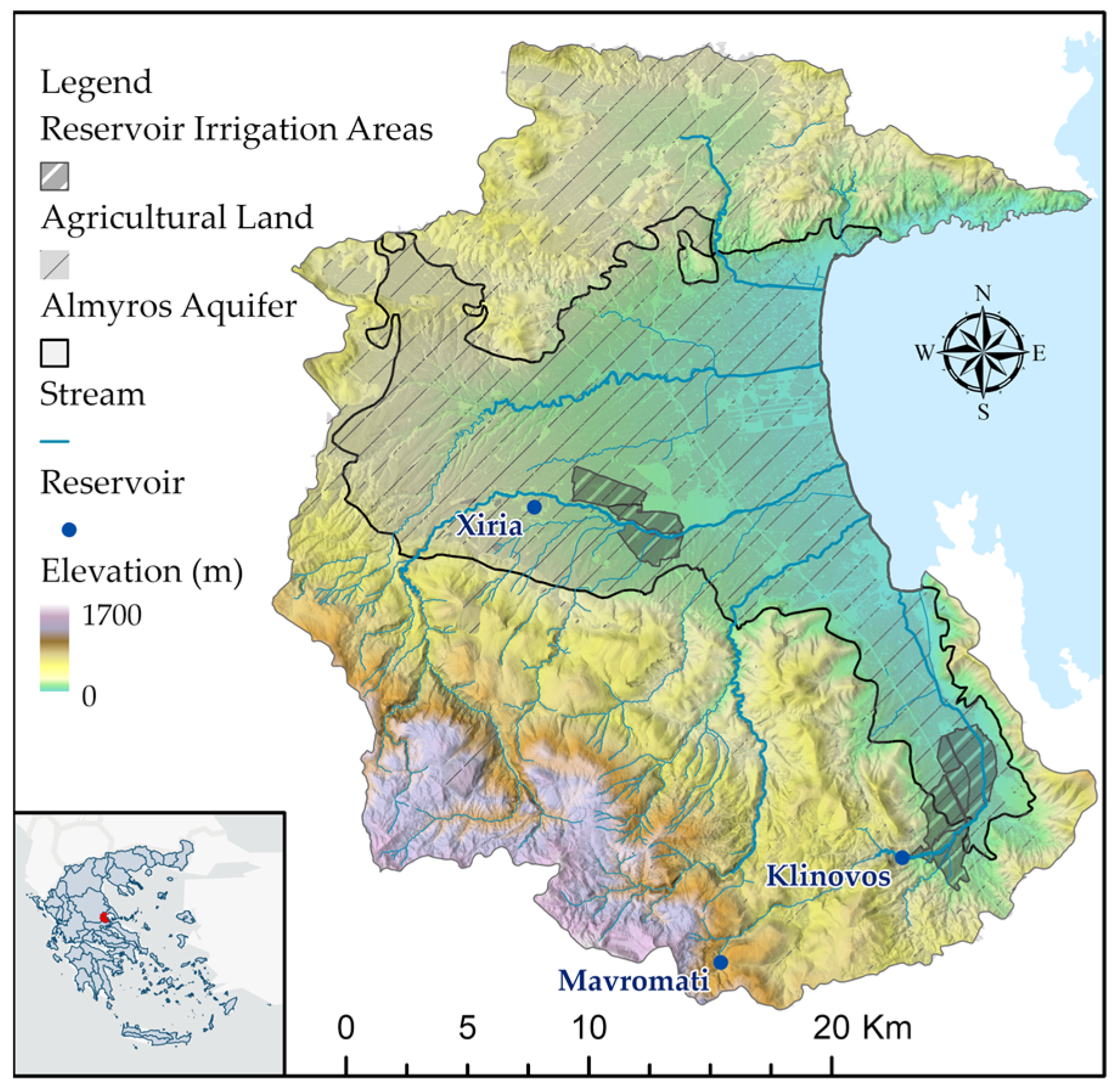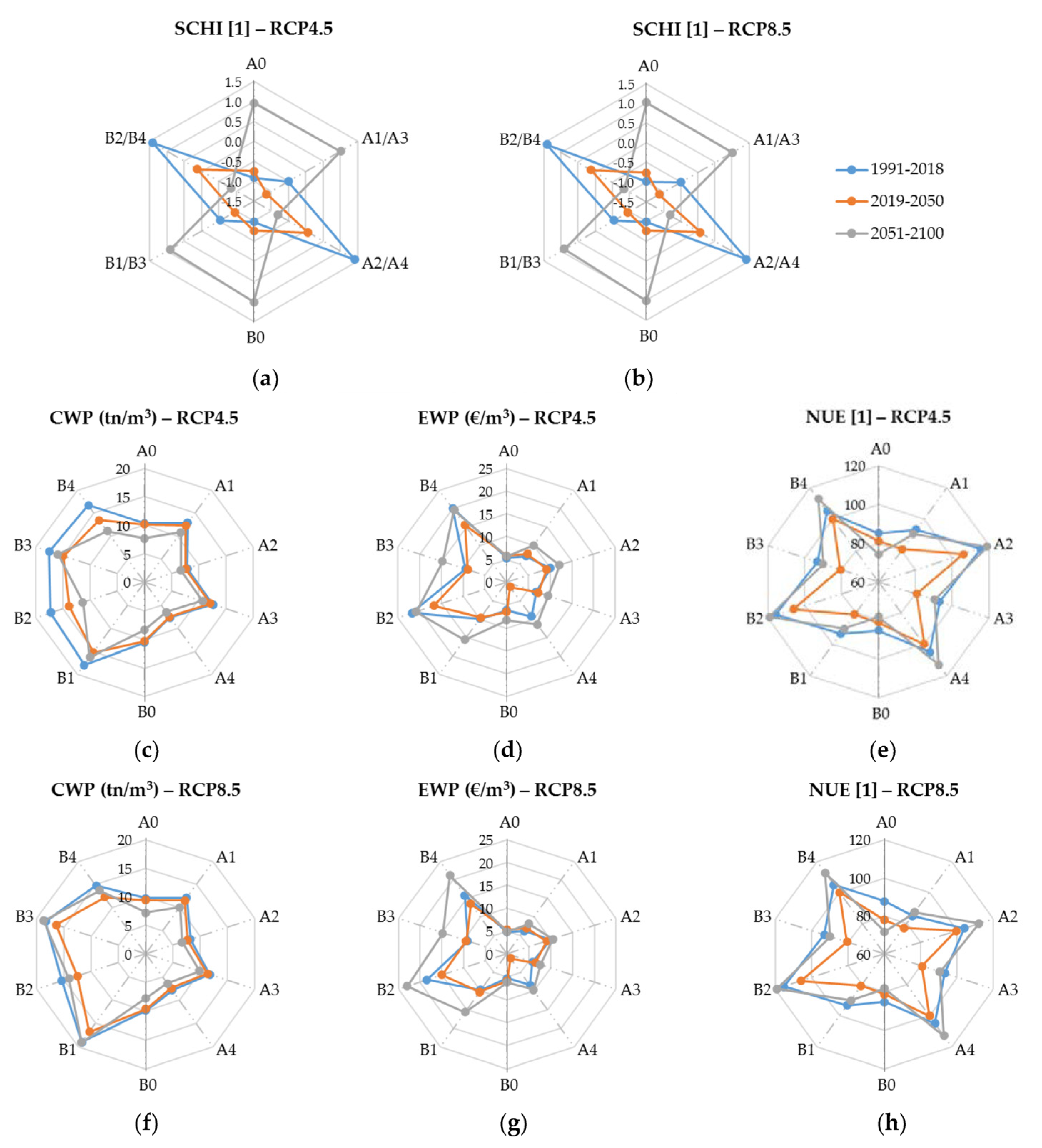Water and Nitrogen Use and Agricultural Production Efficiency under Climate Change in a Mediterranean Coastal Watershed †
Abstract
:1. Introduction
2. Materials and Methods
2.1. Study Area
2.2. Climate Change and Integrated Modelling System
2.3. Water Resources and Agronomic/Crop Scenarios and Strategies
2.4. Salinity, Chlorides Concentration, and Crop Yield
2.5. Agronomic Indices and Standardized Chloride Hazard Index (SCHI)
3. Results-Discussion
3.1. Salinity Impacts on Crop Yield
3.2. Agronomic Efficiency Indices and Water Resource Adaptation for Seawater Intrusion
4. Conclusions
Author Contributions
Funding
Institutional Review Board Statement
Informed Consent Statement
Data Availability Statement
Acknowledgments
Conflicts of Interest
References
- Cheng, M.; Wang, H.; Fan, J.; Wang, X.; Sun, X.; Yang, L.; Zhang, S.; Xiang, Y.; Zhang, F. Crop yield and water productivity under salty water irrigation: A global meta-analysis. Agr. Water Manag. 2021, 256, 107105. [Google Scholar] [CrossRef]
- Lyra, A.; Loukas, A. Simulation and Evaluation of Water Resources Management Scenarios Under Climate Change for Adaptive Management of Coastal Agricultural Watersheds. Water Resour. Manag. 2022. [Google Scholar] [CrossRef]
- Zaman, M.; Shahid, S.A.; Heng, L. Irrigation Water Quality. In Guideline for Salinity Assessment, Mitigation and Adaptation Using Nuclear and Related Techniques; Springer International Publishing: Cham, Switzerland, 2018; pp. 113–131. [Google Scholar]
- Ayers, R.S.; Westcot, D.W. Water Quality for Agriculture; Food and Agriculture Organization of the United Nations: Rome, Italy, 1985; Volume 29. [Google Scholar]
- Lyra, A.; Loukas, A.; Sidiropoulos, P.; Voudouris, K.; Mylopoulos, N. Integrated Modeling of Agronomic and Water Resources Management Scenarios in a Degraded Coastal Watershed (Almyros Basin, Magnesia, Greece). Water 2022, 14, 1086. [Google Scholar] [CrossRef]
- Organisation for Economic Co-Operation and Development; Food and Agriculture Organization of the United Nations. OECD-FAO Agricultural Outlook 2022–2031; FAO: Rome, Italy, 2022. [Google Scholar]


| ECe (dS/m) | ECw (dS/m) (CF = 2.1) | Clw (mg/L) | SCHW Index | Hazard |
|---|---|---|---|---|
| 0–2 | 0–0.95 | 0–100 | <–1.2 | Low with normal yields |
| 2–4 | 0.95–1.90 | 100–360 | −1.2:−0.9 | Low-moderate with yield decrease of sensitive crops |
| 4–8 | 1.90–3.81 | 360–878 | −0.9:−0.1 | Moderate with yield decrease of crops |
| 8–12 | 3.81–5.71 | 878–1397 | −0.1:0.7 | High with yield for tolerant crops |
| >16 | >7.62 | >1916 | >1.5 | Extremely high with yield for tolerant crops |
| Time | A–0 | A–1/A–3 | A–2/A–4 | B–0 | B–1/B–3 | B–2/B–4 |
|---|---|---|---|---|---|---|
| 2019–2050 | −0.3% | 0.3% | 0.3% | −0.3% | 0.3% | 0.3% |
| 2051–2100 | −14.8% | −0.4% | 0.4% | −10.9% | −0.7% | 0.4% |
Disclaimer/Publisher’s Note: The statements, opinions and data contained in all publications are solely those of the individual author(s) and contributor(s) and not of MDPI and/or the editor(s). MDPI and/or the editor(s) disclaim responsibility for any injury to people or property resulting from any ideas, methods, instructions or products referred to in the content. |
© 2023 by the authors. Licensee MDPI, Basel, Switzerland. This article is an open access article distributed under the terms and conditions of the Creative Commons Attribution (CC BY) license (https://creativecommons.org/licenses/by/4.0/).
Share and Cite
Lyra, A.; Loukas, A. Water and Nitrogen Use and Agricultural Production Efficiency under Climate Change in a Mediterranean Coastal Watershed. Environ. Sci. Proc. 2023, 25, 23. https://doi.org/10.3390/ECWS-7-14180
Lyra A, Loukas A. Water and Nitrogen Use and Agricultural Production Efficiency under Climate Change in a Mediterranean Coastal Watershed. Environmental Sciences Proceedings. 2023; 25(1):23. https://doi.org/10.3390/ECWS-7-14180
Chicago/Turabian StyleLyra, Aikaterini, and Athanasios Loukas. 2023. "Water and Nitrogen Use and Agricultural Production Efficiency under Climate Change in a Mediterranean Coastal Watershed" Environmental Sciences Proceedings 25, no. 1: 23. https://doi.org/10.3390/ECWS-7-14180
APA StyleLyra, A., & Loukas, A. (2023). Water and Nitrogen Use and Agricultural Production Efficiency under Climate Change in a Mediterranean Coastal Watershed. Environmental Sciences Proceedings, 25(1), 23. https://doi.org/10.3390/ECWS-7-14180







